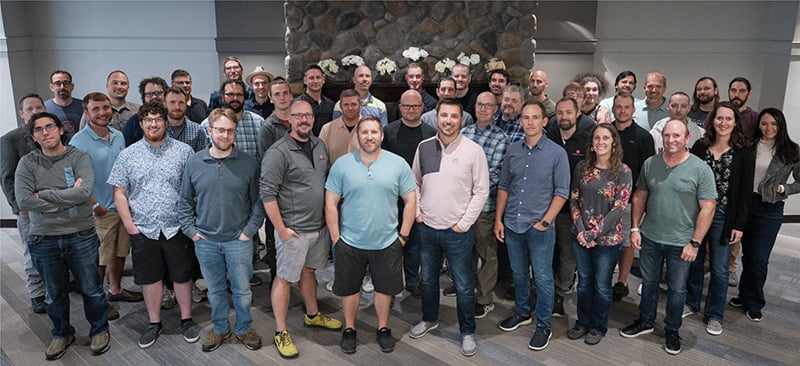In This Blog
- Introduction
- What is Server-Side Rendering (SSR)?
- Why Developers (and Businesses) Prefer SSR
- The Downsides of SSR
- SSR vs. Client-Side Rendering (CSR)
- When Should You Use SSR?
- Hybrid Approaches
- Need Help Deciding?
- FAQ
Introduction
If you’re building a website or web application, you’ve likely encountered the terms Server-Side Rendering (SSR) and Client-Side Rendering (CSR). These two approaches shape how your site loads and performs — and choosing the right one can have a significant impact on user experience and search engine rankings.
I’m Kyle O’Donnell, a Senior Software Engineer at Emergent Software, and I’ve worked extensively with both SSR and CSR. In this post, I’ll break down what SSR is, how it compares to CSR, and when it makes sense to use one over the other.
What is Server-Side Rendering (SSR)?
At its core, Server-Side Rendering (SSR) means that the server generates the full HTML for a web page before sending it to the user's browser. This allows the user to see a fully formed page almost immediately after loading.
In a recent interview on this topic, I noted, “Server-side rendering is a way of generating the web pages where the content and structure of the page are built on the server before being sent to the user's browser. The user receives a fully-formed HTML page that's ready to be displayed without having to wait for any additional scripts or data to download before they're seeing the content.”
How SSR Works
- A user opens a page on your site.
- The server receives the request and gathers the necessary data.
- The server generates the full HTML for the page.
- The fully rendered page is sent to the user’s browser and displayed immediately.
JavaScript can still load in the background to enable additional interactivity, but the core page content is already available.
Popular SSR-Friendly Frameworks
SSR is well-supported by several modern frameworks, including:
- Next.js (React)
- Nuxt.js (Vue)
Why Developers (and Businesses) Prefer SSR
1. Improved SEO
Search engines prefer pages that are ready to crawl upon loading. Since SSR serves fully rendered pages, search engines can easily crawl and index your content without having to process additional JavaScript.
In a recent interview, I explained, “Not all web crawlers can execute JavaScript. Because server-side rendering sends back all the information you need to view the page, all the content is immediately visible to those web crawlers. Even when search engines can process JavaScript, it often requires multiple steps and takes extra time, which can hurt those rankings.”
This means that with SSR, your site's content is available to search engines right away, increasing the chances that it will be indexed quickly and accurately. In contrast, client-side rendering relies on JavaScript to generate content, which means search engines may struggle to access all the information — or take longer to rank it properly.
2. Faster Initial Load Times
SSR improves the perceived performance of a site by reducing the time it takes for users to see meaningful content.
“With server-side rendering, the initial load is going to be pretty quick because the user gets a fully-formed page right away,” I noted.
3. Better Compatibility with Older Devices
Because the server is doing most of the processing, users with older devices or slower internet connections still receive a responsive experience. Since the HTML is already fully constructed when it reaches the browser, the device doesn’t need to do much processing work to display the content. This reduces the strain on weaker processors and ensures that even users with outdated hardware or slower network connections can have a smooth experience.
4. Accurate Previews for Social Media
When someone shares a page on social media, platforms like LinkedIn and Facebook pull in a preview of the page’s content. SSR ensures that those previews are accurate and reflect the latest data because the metadata (such as the title, description, and image) is already included in the server-rendered HTML. This improves how your content appears on social platforms and increases the likelihood of engagement.
5. Accessibility
SSR helps ensure that content is immediately available, which improves compatibility with screen readers and other assistive technologies. Because the HTML is fully formed when it reaches the browser, screen readers can parse the content without relying on JavaScript execution. This makes it easier for users with visual impairments or other disabilities to access and navigate the content.
The Downsides of SSR
1. Increased Server Load
SSR places more demand on the server because the server is responsible for generating the HTML for each request.
“One of the drawbacks with server-side rendering is because you have to build that fully-rendered HTML on the server, that’s going to require more processing power and work,” I explained. “Depending on how many people are hitting your website, that might require more scaling out, which can get more expensive.”
2. Slower Page-to-Page Navigation
While the initial load is faster with SSR, moving between pages may feel slower because each page requires a new server request and full HTML generation.
3. Complexity
Setting up SSR requires more effort compared to CSR. If your team is not familiar with server-side frameworks, the learning curve can be steep.
4. Compatibility Issues
Certain client-side libraries and tools that rely heavily on JavaScript execution may not work as expected with SSR. For example, libraries that rely on window or document objects — which are only available in the browser environment — can cause issues since they aren't accessible during server-side rendering. Additionally, animations and event listeners that depend on client-side JavaScript execution might not work properly until the client-side scripts have loaded and taken over the page's functionality.
SSR vs. Client-Side Rendering (CSR)
In contrast to SSR, Client-Side Rendering (CSR) shifts the responsibility of building the page to the browser. The server sends a minimal HTML file along with JavaScript, which then fetches the necessary data and renders the page dynamically.
In a recent interview, I described it this way: “With client-side rendering, the browser initially receives the basic HTML structure and JavaScript files. The JavaScript then runs, grabs any additional data, and you’re constructing the page more dynamically within the user's browser.”
| FEATURE | Server-Side Rendering (SSR) | Client-Side Rendering (CSR) |
|---|---|---|
|
SEO |
✅ Better | ❌ Worse |
|
First Page Load |
✅ Faster |
❌ Slower |
| Subsequent Page Loads | ❌ Slower | ✅ Faster |
|
Server Load |
❌ Higher | ✅ Lower |
|
Interactivity |
❌ Needs extra work | ✅ Built-in |
When Should You Use SSR?
SSR is particularly effective for:
- Static web pages – Sites that prioritize SEO.
- E-commerce sites – Faster load times can improve conversion rates.
- News sites and blogs – Content visibility and searchability are critical.
- Social media platforms – Ensures accurate previews and quick content visibility.
Hybrid Approaches
Many modern applications use a hybrid approach — combining SSR for initial page loads and CSR for subsequent page interactions.
“There’s a lot of emerging technology nowadays to go for more of a hybrid approach,” I mentioned. “You get server-side for those initial loads and other benefits, and then client-side for those subsequent interactions.”
Need Help Deciding? Let’s Talk.
At Emergent Software, we’ve helped many businesses find the right rendering approach for their specific needs. Whether you’re starting a new project or looking to optimize an existing site, we’re here to help.
Ready to improve your website’s performance? Reach out today!
FAQ
What is server-side rendering?
Server-side rendering (SSR) is a web development technique where a webpage is fully processed and generated on the server before being sent to the user's browser. This means that when a user requests a page, the server compiles the HTML, including dynamic content, and delivers a fully-rendered page. Because of this, users experience faster initial load times, as they don’t have to wait for JavaScript to execute before seeing content.
What is the difference between SSR and CSR?
The main difference between server-side rendering (SSR) and client-side rendering (CSR) lies in where the page is generated. SSR processes and builds the webpage on the server, sending fully-formed HTML to the browser, which improves performance and SEO. In contrast, CSR loads a minimal HTML shell and relies on JavaScript to fetch and render content dynamically in the browser, which can lead to slower initial load times but allows for more interactive user experiences.
Why is SSR better for SEO?
SSR is beneficial for SEO because it ensures that search engine crawlers receive fully-rendered HTML pages without needing to execute JavaScript. Search engines like Google can more easily index content, leading to better rankings and visibility. In contrast, CSR can create challenges for SEO since crawlers may struggle to interpret JavaScript-heavy pages, potentially reducing how well they are indexed.
What is SSR used for?
SSR is commonly used for websites where fast initial load times and search engine visibility are crucial. It is ideal for content-heavy platforms such as news websites, blogs, e-commerce stores, and social media applications. These sites benefit from SSR because it enhances performance, improves SEO, and provides users with immediate access to fully-rendered content.
Is SSR more expensive than CSR?
SSR can be more expensive than CSR because it requires additional server resources to process and render pages before delivering them to users. High-traffic websites using SSR may experience increased server load, leading to higher hosting and infrastructure costs. However, these costs can be justified by the improved performance, SEO benefits, and better user experience SSR provides.
Can you combine SSR and CSR?
Yes, many modern applications use a hybrid approach that combines SSR and CSR to optimize performance and interactivity. A common strategy is to use SSR for the initial page load to ensure fast rendering and good SEO while leveraging CSR for dynamic updates and interactions without requiring a full-page refresh. This approach provides the best of both worlds by balancing speed, efficiency, and user engagement.






